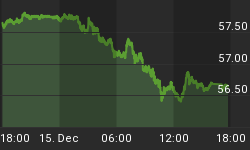In looking around a "What if?" moment seems to be arriving.
What will policymakers do as this phase of contraction becomes more obvious?
More of the same?
Or perhaps they have one last trick?
Markets are beginning to suffer central bank fatigue, and now the establishment is beginning to talk about the wonders of fiscal manipulation.
Many are getting concerned about what policymakers may do as frustration forces even more desperate measures.
Also, policymakers are fully committed to theories that have been impractical since they were first confected. The establishment does not understand this and will not willingly quit - well - policymaking.
Incapable of self-criticism, the only way it will end is to have the public condemn and then constrain radical central banking.
From around the early 1700s to the 1920s the senior central bank (Bank of England) dedicated itself to maintaining the gold backing of the currency. At times of financial distress it was an acute challenge (there was a lapse of discipline from 1797 to 1819). Eventually, speculative positions in the markets would be liquidated. This would clear and all would be well. Until the next outbreak of speculation. Which would be followed by another liquidity crisis. A hundred years of growing intrusion has not changed the basic patterns that recur in financial history.
It was widely understood that the ultimate challenge to central banking was to maintain a sound currency. Also it was widely appreciated that free markets would provide goods and services better than any other system. Urges to commit mercantilism were always lurking, but constrained.
Notions about government intervention to make things better have been around since at least the 1618 Crash. In 1873, the esteemed editor of The Economist wrote that with the injection of sufficient liquidity the central bank could prevent a contraction. This has been trashed frequently since. The 1873 Bubble peaked that summer and crashed in the fall. By 1884 the contraction was enduring and bad enough to be called the "Great Depression". It ended on its own in 1895.
Generally, intrusion was considered impractical. It was best to let the imbalances clear on their own. This is still practical, but since the early 1900s a culture of economic intrusion has been continuously imposed.
Even celebrated, as the pitch has been versatile. Business expansions can be made better and made to last longer than otherwise. Setbacks need not happen, but in case they do, the Fed can prevent them from being worse than otherwise.
This ideology was shocked by the severity of the "Great Recession".
The big concern now is not so much about another phase of the contraction with weakening commodities and dislocated stock and bond markets. It is what policymakers may do in extreme desperation. Policymaking itself is increasingly seen as a threat. The irony is that prior to the world of busy-body intrusion it was widely known that excesses always cleared on their own.
The consequence of the drive for arbitrary perfection is a world of serial and dislocating bubbles.
The problem with intrusive policymakers is that they don't understand the self-correcting nature of financial markets. Instead of allowing corrections, central bankers have been ambitious for constant growth.
Some of the concern is from sources that some years ago became famous for predicting a "crack-up" bust that would drive gold's price to $10,000. Decades ago we could find nothing in financial history that would enable the Institutional Advisors team to seek such fame. Not even half a unit of fame.
We did find that in a typical post-bubble contraction gold's real price would almost double. This has had a proportionate increase in operating margins for gold miners, making it a premier industry in a Great Depression.
Now there is the growing dread about what harm inspired policymakers can really do to the social and business fabric. It is important to understand that the most intense experiment in authoritarian government has been on for over a hundred years. The last example ran for over a hundred years and ended in the early 1600s.
In England, it took decades to complete the Great Reformation with the concluding step being the "Glorious Revolution" of 1688.
Another severe contraction is inevitable and the ultimate threat from policymakers (whatever it may be) could be overwhelmed. In the meantime and specifically, how would even more desperate measures be imposed?
Actually, most ideas about intrusion were imposed in the 1930s.
Banning cash transactions would be disruptive but it might please the governing classes, briefly.
Price and wage controls would be a natural. These were tried in Rome in the late 300s to stop government-induced inflation. Even when backed by the sword, they did not work. They were tried in Canada and the US in the early 1970s. Then there was the control system with no price mechanism. Called Communism, it was tried in Eastern Europe and in China.
The latter's historical failures were massive and well-understood. As will soon be the current experiment in big business and big government, otherwise known as fascism.
Virtually all of the tools of intervention have been or are being tried now. But no matter how intense the effort, all they are doing is trying to prove that correlation is indeed causation.
Fed credit expansion always forces economic expansion.
Except when it forces asset bubbles.
The best way out of compulsive intrusion is that the contraction will hit all asset classes, from high-end real estate to carbon credits. And fast enough to completely overwhelm any day-to-day attempts by central bankers to stem it.
A severe enough break could prompt the general taxpayer to condemn the waste of money on impractical schemes promoted by so many generations of financial adventurers.
Forensic accounting and forensic medicine have been around for a long time. There is a screaming need for forensic economics and forensic policymaking.















